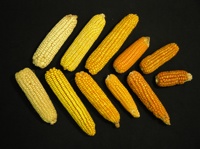![]() Vitamin A deficiency causes eye disease in 40 million children each year and places another 200 million or thereabouts at risk for other health problems. In sub-Saharan Africa and Latin America, between 17% and 30% of children under the age of 5 suffer vitamin A deficiency. Simple solution: give them more vitamin A. But how?
Vitamin A deficiency causes eye disease in 40 million children each year and places another 200 million or thereabouts at risk for other health problems. In sub-Saharan Africa and Latin America, between 17% and 30% of children under the age of 5 suffer vitamin A deficiency. Simple solution: give them more vitamin A. But how?
The poorest regions, which stand to benefit most, often do not have the infrastructure to deliver vitamin supplements, either directly or in fortified foods. Diversifying the diet is dismissed out of hand. ((Full disclosure: I don’t myself buy the reasons given for not doing more to diversify diet, but this is not the place for that argument. This is: Johns, T. & Eyzaguirre, P. B. (2007). Biofortification, biodiversity and diet: A search for complementary applications against poverty and malnutrition. Food Policy, 32(1), 1-24.)) So the technical types turn to plant breeding, and in particular the notion of biofortified foods, whereby staple crops are selected to contain higher levels of micronutrients. It was this approach that gave the world Golden Rice, by shifting one of the enzymes in the carotenoid synthesis pathway from daffodil to rice.
An ungrateful world still has not accepted golden rice as the saviour of blind little children, but the technical types have not stopped working. In the latest Science ((Harjes, C.E., Rocheford, T.R., Bai, L., Brutnell, T.P., Kandianis, C.B., Sowinski, S.G., Stapleton, A.E., Vallabhaneni, R., Williams, M., Wurtzel, E.T., Yan, J., Buckler, E.S. (2008). Natural Genetic Variation in Lycopene Epsilon Cyclase Tapped for Maize Biofortification. Science, 319(5861), 330-333. DOI: 10.1126/science.1150255)) a large team led by Edward Buckler at Cornell University, reports on a different approach to biofortification.

So what other staples are there, preferably ones that might already contain the genes to make vitamin A precursors? Step forward maize, some varieties of which have yellow and even golden orange kernels. It is not enough, however, simply to look at the maize kernels and score them on some scale from pale yellow to deep orange. The reason is that not all carotenoids are created equal. Beta carotene is the precursor of choice, because it contains two of the necessary chemical rings to make vitamin A. Shade of yellow correlates very poorly with total beta-carotene. But all this is detail above and beyond the call of duty. The point is that maize varieties display enormous variability both in total carotenes and in the proportion of beta carotene.
Maize varieties are also hugely genetically diverse. In fact, the differences between two maize varieties is considerably greater than the difference between humans and chimpanzees. Buckler’s group took the known variability in maize kernel colour and asked whether genetic differences were associated with the carotene profile of the variety. They were. The gene for one particular enzyme — lycopene epsilon cyclase — has a large effect on the provitamin A carotenoids.
There’s more in the full paper (which requires a subscription), but one reason that this could be an important result is that it is reasonably easy for others to make use of it. Genetic markers for the favourable versions of the crucial gene make it possible for breeders to look for the potential in any varieties they have that are already adapted to the conditions for which they are breeding. The favourable type is reasonably widespread, so finding parents for crosses should be reasonably easy. Analyzing carotenoid compounds is expensive and difficult, but scoring the target gene is not only about 1000 times cheaper, it is also well within the capabilities of those developing countries that need more vitamin A.
The contrast with Golden Rice couldn’t be greater. That is a proprietary technology that has graciously been made available to those who have the expertise to make use of it. This approach to a nutritionally-improved maize should be much simpler to put to work. Information needed for the DNA analysis is being made freely available, as are inbred maize lines that could make it easier for breeders worldwide. So things look good for biofortified maize, at least technically.
There’s just one remaining little problem — will people eat yellow maize, even if they know it is good for them? Changing human feeding behaviour can be so much harder than changing the food they eat.
Stop press: Prefer wheat to maize or rice? Golden wheat comes a step closer too, with a paper in Euphytica. Italian and Spanish wheat breeders transferred nuclei from wheat into cells from wild barley and from wild wheat relatives. Wheat wild relatives increased the amount of lutein, another carotenoid.